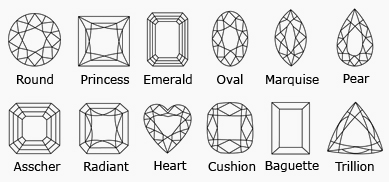Diamond cutting is the art and science of creating a gem-quality diamond out of mined rough. The cut of a diamond describes the manner in which a diamond has been shaped and polished from its beginning form as a rough stone to its final gem proportions. The cut of a diamond describes the quality of workmanship and the angles to which a diamond is cut. Often diamond cut is confused with “shape”.
There are mathematical guidelines for the angles and length ratios at which the diamond is supposed to be cut in order to reflect the maximum amount of light. Round brilliant diamonds, the most common, are guided by these specific guidelines, though fancy cut stones are not able to be as accurately guided by mathematical specifics.

The techniques for cutting diamonds have been developed over hundreds of years, with perhaps the greatest achievements made in 1919 by mathematician and gem enthusiast Marcel Tolkowsky. He developed the round brilliant cut by calculating the ideal shape to return and scatter light when a diamond is viewed from above. The modern round brilliant has 57 facets (polished faces), counting 33 on the crown (the top half), and 24 on the pavilion (the lower half). The girdle is the thin middle part. The function of the crown is to refract light into various colors and the pavilion’s function to reflect light back through the top of the diamond.
Tolkowsky’s calculations included some approximations. He calculated the ideal dimensions as:
Table percentage (corner-to-corner diameter of the table divided by overall diameter) = 53%
Depth percentage (overall depth divided by overall diameter) = 59.3% (not including adjustments for the culet height and girdle thickness)
Pavilion Angle (angle between the girdle and the pavilion main facets) = 40.75°
Crown Angle (angle between the girdle and the crown’s kite facets) = 34.5°
Pavilion Depth (depth of pavilion divided by overall diameter) = 43.1%
Crown Depth (depth of crown divided by overall diameter) = 16.2%

The culet is the tiny point or facet at the bottom of the diamond. This should be a negligible diameter, otherwise light leaks out of the bottom. Tolkowsky’s calculations included neither a culet nor a girdle. However, a girdle is required in reality in order to prevent the diamond from easily chipping in the setting. The thick part of the girdle is normally about 1.7% (of the overall diameter) thicker than the thin part of the girdle.
The further the diamond’s characteristics are from the Tolkowsky’s ideal, the less light will be reflected. However, there is a small range in which the diamond can be considered “ideal”. Tolkowsky’s calculations can be repeated for a narrow range of pavilion angles. Such calculations show a slightly larger table percentage, and a trade-off between pavilion angle and crown angle.
Today, because of the relative importance of carat weight among buyers, many diamonds are often intentionally cut poorly to increase carat weight. There is a financial premium for a diamond that weighs the desirable 1.0 carat (200 mg), so often the girdle is made thicker or the depth is increased. Neither of these changes makes the diamond appear any larger, and both greatly reduce the sparkle of the diamond. (A poorly cut 1.0 carat (200 mg) diamond may have the same diameter and appear as large as a 0.85 carats (170 mg) diamond.) The depth percentage is the overall quickest indication of the quality of the cut of a round brilliant. “Ideal” round brilliant diamonds should not have a depth percentage greater than 62.5%. Another quick indication is the overall diameter. Typically a round brilliant 1.0 carat (200 mg) diamond should have a diameter of about 6.5 mm. Mathematically, the diameter in millimeters of a round brilliant should approximately equal 6.5 times the cube root of carat weight, or 11.1 times the cube root of gram weight, or 1.4 times the cube root of point weight.
There are also many different shapes of diamonds. Below is an image that shows some of the most common shapes in the industry which can be purchased today.
